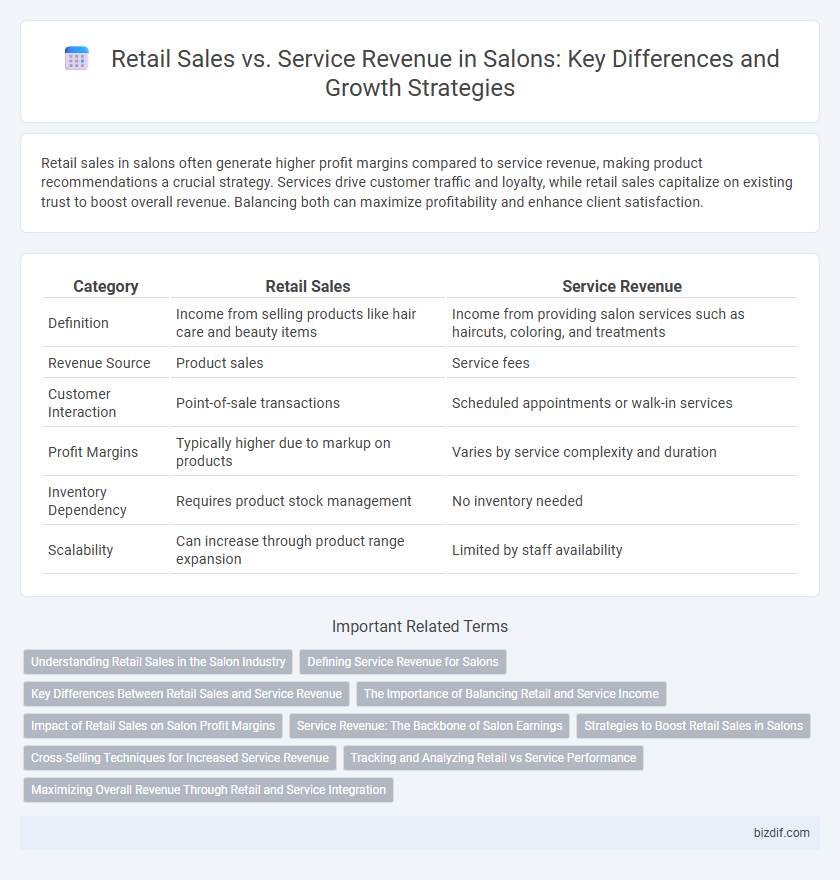Retail sales in salons often generate higher profit margins compared to service revenue, making product recommendations a crucial strategy. Services drive customer traffic and loyalty, while retail sales capitalize on existing trust to boost overall revenue. Balancing both can maximize profitability and enhance client satisfaction.
Table of Comparison
| Category | Retail Sales | Service Revenue |
|---|---|---|
| Definition | Income from selling products like hair care and beauty items | Income from providing salon services such as haircuts, coloring, and treatments |
| Revenue Source | Product sales | Service fees |
| Customer Interaction | Point-of-sale transactions | Scheduled appointments or walk-in services |
| Profit Margins | Typically higher due to markup on products | Varies by service complexity and duration |
| Inventory Dependency | Requires product stock management | No inventory needed |
| Scalability | Can increase through product range expansion | Limited by staff availability |
Understanding Retail Sales in the Salon Industry
Retail sales in the salon industry encompass products such as shampoos, conditioners, styling tools, and hair treatments that clients purchase for at-home use. These sales contribute significantly to overall revenue, often presenting higher profit margins compared to services like haircuts, coloring, and styling. Understanding retail trends and inventory management is essential for salons to maximize revenue streams and enhance client satisfaction through personalized product recommendations.
Defining Service Revenue for Salons
Service revenue in salons encompasses income generated from professional treatments such as haircuts, coloring, styling, skincare, and spa services. It reflects the value of expertise and personalized care provided to clients, distinguishing it from retail sales, which involve product purchases like shampoos and styling tools. Accurate tracking of service revenue is essential for salons to analyze business performance and optimize pricing strategies.
Key Differences Between Retail Sales and Service Revenue
Retail sales in salons involve the direct sale of hair care products, styling tools, and beauty accessories, generating immediate revenue through physical or online purchases. Service revenue is earned from professional treatments such as haircuts, coloring, and spa services, often representing a larger portion of total income due to repeat bookings and higher transaction values. Key differences include inventory management for retail products versus labor-intensive service delivery, with retail revenue being less variable and service revenue heavily dependent on appointment scheduling and client retention.
The Importance of Balancing Retail and Service Income
Balancing retail sales and service revenue is essential for a salon's financial stability and growth. Retail product sales provide a steady income stream that complements fluctuating service appointments, while service revenue drives customer engagement and loyalty through personalized treatments. A harmonious balance between both income sources enhances profitability, client satisfaction, and brand reputation in the competitive salon industry.
Impact of Retail Sales on Salon Profit Margins
Retail sales significantly boost salon profit margins by providing higher-margin products compared to service revenue. Selling professional haircare and beauty products increases overall revenue without the time constraints of service appointments. Effective retail sales strategies enhance client satisfaction and loyalty while driving consistent incremental profits.
Service Revenue: The Backbone of Salon Earnings
Service revenue constitutes the backbone of salon earnings, often accounting for over 70% of total income. High-quality services such as haircuts, coloring, and skincare treatments drive client retention and establish consistent cash flow. Emphasizing exceptional service experiences boosts customer loyalty, which in turn increases overall profitability beyond retail sales alone.
Strategies to Boost Retail Sales in Salons
Enhancing retail sales in salons requires targeted strategies such as personalized product recommendations based on client needs, staff training to improve product knowledge and upselling techniques, and creating attractive product displays that encourage impulse purchases. Implementing loyalty programs and offering exclusive promotions tied to salon services can increase customer engagement and repeat retail purchases. Leveraging digital tools like online product booking and post-appointment follow-ups with product suggestions also drives retail revenue growth alongside service income.
Cross-Selling Techniques for Increased Service Revenue
Cross-selling techniques in salons strategically promote service add-ons and retail products, significantly boosting overall service revenue. By recommending complementary products like hair treatments alongside styling services, salons enhance client satisfaction and increase average transaction value. Effective staff training in product knowledge and personalized client consultations drives higher conversion rates in both retail sales and service upgrades.
Tracking and Analyzing Retail vs Service Performance
Tracking retail sales and service revenue separately allows salons to identify their most profitable revenue streams and optimize inventory management. Analyzing key performance indicators like average transaction value, product sell-through rates, and service frequency helps pinpoint growth opportunities. Implementing salon management software with detailed reporting features enhances the accuracy and efficiency of retail and service performance analysis.
Maximizing Overall Revenue Through Retail and Service Integration
Maximizing overall salon revenue requires strategic integration of retail sales and service offerings, leveraging product recommendations that complement specific treatments to boost client satisfaction and repeat purchases. Implementing staff training programs focused on upselling retail products during service appointments enhances average transaction value and strengthens brand loyalty. Tracking key performance indicators such as retail attach rate and service revenue growth enables salons to fine-tune their approach for balanced income streams and sustained profitability.
Retail Sales vs Service Revenue Infographic

 bizdif.com
bizdif.com